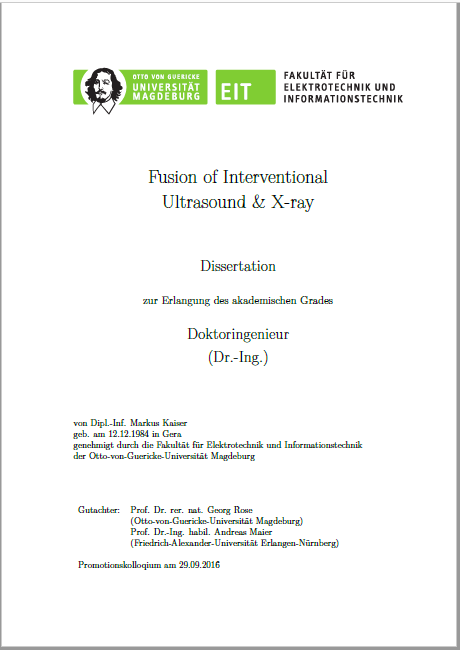Vol. 71 (2016): Kaiser, Markus: Fusion of interventional ultrasound & X-ray

Today, in an elderly community, the treatment of structural heart disease will become more and more important. Constant improvements of medical imaging technologies and the introduction of new catheter devices caused the trend to replace conventional open heart surgery by minimal invasive interventions.
These advanced interventions need to be guided by different medical imaging modalities. The two main imaging systems here are X-ray fluoroscopy and Transesophageal Echocardiography (TEE). While X-ray provides a good visualization of inserted catheters, which is essential for catheter navigation, TEE can display soft tissues, especially anatomical structures like heart valves. Both modalities provide real-time imaging and are necessary to lead minimal invasive heart surgery to success. Usually, the two systems are detached and not connected. It is conceivable that a fusion of both worlds can create a strong benefit for the physicians. It can lead to a better communication within the clinical team and can probably enable new surgical workflows.
Because of the completely different characteristics of the image data, a direct fusion seems to be impossible. Therefore, an indirect registration of Ultrasound and X-ray images is used. The TEE probe is usually visible in the X-ray image during the described minimal-invasive interventions. Thereby, it becomes possible to register the TEE probe in the fluoroscopic images and to establish its 3D position. The relationship of the Ultrasound image to the Ultrasound probe is known by calibration. To register the TEE probe on 2D X-ray images, a 2D-3D registration approach is chosen in this thesis. Several contributions are presented, which are improving the common 2D-3D registration algorithm for the task of Ultrasound and X-ray fusion, but also for general 2D-3D registration problems. One presented approach is the introduction of planar parameters that increase robustness and speed during the registration of an object on two non-orthogonal views.
Another approach is to replace the conventional generation of digital reconstructed radiographs, which is an integral part of 2D-3D registration but also a performance bottleneck, with fast triangular mesh rendering. This will result in a significant performance speed-up. It is also shown that a combination of fast learning-based detection algorithms with 2D-3D registration will increase the accuracy and the capture range, instead of employing them solely to the registration/detection of a TEE probe. Finally, a first clinical prototype is presented which employs the presented approaches and first clinical results are shown.
ISBN: 978-3-944722-51-1

